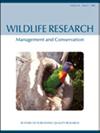Bird community structure and habitat association in Owabi Wildlife Sanctuary, Ashanti Region (Ghana)
IF 1.6
3区 生物学
Q3 ECOLOGY
引用次数: 0
Abstract
ABSTRACT Context. Globally, an estimated 1.3% of the bird species have gone extinct over the past millennia, largely owing to habitat loss. Aims. This study investigated bird–habitat associations and assemblages in the Owabi Ramsar wetland. Methods. The study was conducted over 5 months (May–September 2019) in four habitat types (agricultural land, built-up, forest reserve, and open-water area). Data were collected in 84 plots across four habitats (i.e. built-up area = 25, forest reserve = 25, agricultural land = 25 and open-water area = 9 plots), using a point-count technique. The Gambin model, non-metric multidimensional scaling, Chao-1, and Hill numbers models were used to evaluate differences in bird diversity and composition among the habitat types. Key results. In all, 1260 individual birds, belonging to 81 species, were encountered. Many of the species occurred in the forest habitat (n = 46, 56.8%. Species from the agricultural land (n = 37) and built-up (n = 30) were mainly habitat generalists that used these two habitats as their shared feeding station. Bird–habitat specialisation grouping equally showed the forest specialists to be the highest (n = 23, 38.4%), whereas the open water had the least number of habitat specialisation associations (e.g. white-faced whistling duck, n = 20, 24.7%). Five species were widely distributed in all four habitats (e.g. bronze-mannikins and white-throated bee-eaters), indicating their broad habitat preferences and ability to adapt to varied conditions. The forest reserve tended to be the most diverse, which was likely mediated by factors such as nesting microhabitats, varied food availability, and human-led activities. Conclusions. This study highlighted bird dietary structure and associated habitat type and bird-habitat specialisation in four different land-use types at Owabi Ramsar wetland. Implications. Given the increasing level of disturbance, there is the likelihood that the population of forest-dependent and open water-dependent birds will be lost or will have to change or modify their behaviour to be similar to that of open-tolerant or open-country birds if managers of the Owabi Wildlife Sanctuary fail to implement the recommended management interventions highlighted.加纳阿散蒂地区奥瓦比野生动物保护区鸟类群落结构与栖息地关联
抽象的上下文。在过去的一千年里,全球估计有1.3%的鸟类灭绝,主要是由于栖息地的丧失。目标研究了奥瓦比拉姆萨尔湿地鸟类与栖息地的关系和组合。方法。该研究在五个多月(2019年5月至9月)的时间里,在四种栖息地类型(农业用地、建成区、森林保护区和开放水域)进行。采用点计数技术,在4个生境(建成区= 25个,森林保护区= 25个,农田= 25个,开放水域= 9个)的84个样地收集数据。采用Gambin模型、非度量多维尺度模型、Chao-1模型和Hill数模型评价了不同生境类型间鸟类多样性和组成的差异。关键的结果。总共发现了81种1260只鸟。以森林生境居多(n = 46, 56.8%)。农业用地(n = 37)和建筑用地(n = 30)以生境通用型为主,将这两个生境作为共同的取食站。鸟类-栖息地专门化分组结果显示,森林专门化组合数量最多(n = 23, 38.4%),而开阔水域的栖息地专门化组合数量最少(如白面啸鸭,n = 20, 24.7%)。4种生境中有5种分布广泛(如青铜人兽和白喉蜂),表明它们对生境的偏好和适应能力广泛。森林保护区往往是最多样化的,这可能是由筑巢微栖息地、不同的食物供应和人类主导的活动等因素介导的。结论。本研究重点分析了奥瓦比拉姆萨尔湿地4种不同土地利用类型下鸟类的食性结构、栖息地类型和鸟类栖息地的专一性。的影响。考虑到干扰程度的增加,如果奥瓦比野生动物保护区的管理人员未能实施重点强调的建议管理干预措施,那么依赖森林和开放水域的鸟类种群可能会消失,或者不得不改变或修改它们的行为,使其与开放耐受或开放乡村鸟类相似。
本文章由计算机程序翻译,如有差异,请以英文原文为准。
求助全文
约1分钟内获得全文
求助全文
来源期刊

Wildlife Research
生物-动物学
CiteScore
4.30
自引率
15.80%
发文量
56
审稿时长
3 months
期刊介绍:
Wildlife Research represents an international forum for the publication of research and debate on the ecology, management and conservation of wild animals in natural and modified habitats. The journal combines basic research in wildlife ecology with advances in science-based management practice. Subject areas include: applied ecology; conservation biology; ecosystem management; management of over-abundant, pest and invasive species; global change and wildlife management; diseases and their impacts on wildlife populations; human dimensions of management and conservation; assessing management outcomes; and the implications of wildlife research for policy development. Readers can expect a range of papers covering well-structured field studies, manipulative experiments, and analytical and modelling studies. All articles aim to improve the practice of wildlife management and contribute conceptual advances to our knowledge and understanding of wildlife ecology.
Wildlife Research is a vital resource for wildlife scientists, students and managers, applied ecologists, conservation biologists, environmental consultants and NGOs and government policy advisors.
Wildlife Research is published with the endorsement of the Commonwealth Scientific and Industrial Research Organisation (CSIRO) and the Australian Academy of Science.
 求助内容:
求助内容: 应助结果提醒方式:
应助结果提醒方式:


